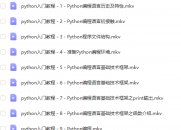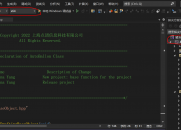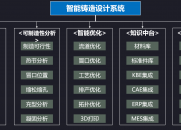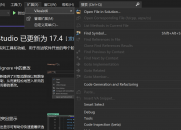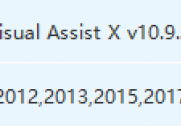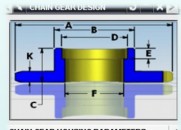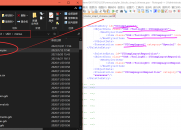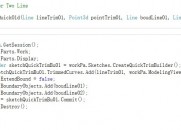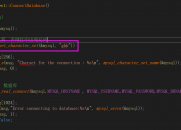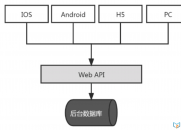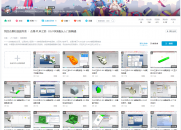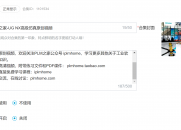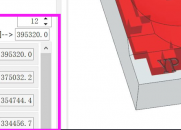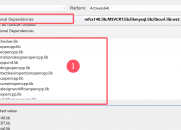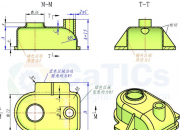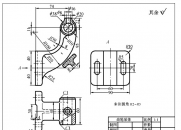|
|
请使用QQ关联注册PLM之家,学习更多关于内容,更多精彩原创视频供你学习!
您需要 登录 才可以下载或查看,没有账号?注册

x
Manufacturing Process Management allows you to manage manufacturing
. X; f% ?5 F3 uplanning and execution, using information generated in the design stage.
" ]1 a8 S2 G& v' T* M1 O; EThe manufacturing planning model includes several interrelated process and* l/ r5 r7 c0 k; a
operation types, as follows:
9 p/ i8 w) ~3 r5 y) K! T
* }% L* d/ c8 P4 NManufacturing process
2 f+ i* F1 d" S& S( HA set of manufacturing process operations and other manufacturing g+ Q% n: c6 h
processes that are closely related to each other. It is a mechanism to group
$ B5 R2 @7 M) ~+ k. q' coperations into logical groups. It also maintains constraints on the order
. R7 A3 i6 [0 _of execution between subprocesses and process operations.
, [1 L. P8 x8 I* L9 l7 RThe process structure is the model of the complete manufacturing plan,
) H+ A4 \+ g# d( hand describes how and where the product is manufactured. It contains
7 Q" _2 f* Z4 ]& c7 H, Yinformation about which plant structure elements are used and where.
( E3 x/ h: R9 M( Q$ `2 H JIt establishes links between the product, plant layout, and the resources& X$ |3 E. `! A5 E( S6 j
necessary to produce the product.1 a6 g4 x9 `) Q) ^
Operations and resources can be shared by several processes. You can
# a( f" h+ C Z H; x' g4 sdefine multiple views of a process to allow for different manufacturing$ l i& P% o1 w5 c! z
requirements.7 ~8 N0 g/ `6 M, B8 C' Z: h
You can also vary the generic bill of process (BOP) by defining and
: f4 B$ R9 r4 U0 zapplying variant or revision rules.7 c$ u2 Y- v9 C, L$ H# M( s
+ Y& L4 V& @ T9 ^8 I
Process operation8 ?& Q, S8 k- B9 A
A process operation represents one controlled step in the process and
0 \- w4 W1 w& y( [! T4 s4 `contains the work done in one work area; technically, it is a leaf node
( u9 f9 G" x& e9 n2 B6 `in the process structure. Optionally, you can break a process operation0 |1 @4 W' Z3 s
into steps called activities. Examples of process operations include an$ ~ d5 ?" L) T! C
NC machining operation on a single machine tool and an operation to
6 @; G2 |& j5 F, [- l1 rassemble several components into a structure.
9 M9 X# `0 G2 `* Q6 X0 l( t( J( G) [" ?$ N ~
Operation activities# \+ [" u1 ~8 @$ { x
A breakdown of manufacturing process operations into activities, each
: N; {9 H5 d/ Dwith an associated start time and duration. The total time of an operation
( N. q2 W9 \( b Ois calculated from the start time and duration of each activity. E5 x/ I3 K1 O% l& V
- J: c O o% y2 @' ~0 M! b
Workstation
* s) o+ V4 `! W6 @" N5 dA unique location within the factory to which you can assign& A4 w* X* B/ [
manufacturing operations, for example, a paint spraying booth.
- c6 W% I: v0 z% _; U% e8 o% ]) H8 b, ~/ P, T
Plant9 i$ e: w1 G& a' ~: F) L& E1 G* g% o- u
A manufacturing facility in which operations and processes are executed.. Y, L# h1 r8 D* f( a! Y
The plant structure is hierarchical structure of work areas of the factory( ~+ \6 T5 C/ R( h
in which the product is manufactured. Its definition is independent of, but. P( |: _* ?6 G' _9 C. y! F
related to, the manufacturing processes that are performed in it.& g0 x4 ]7 y5 J/ t9 ^
; N! u% m X2 @& e
9 f5 E. {- v2 h4 x- P& H- E/ ~
Work area7 n2 ^7 q4 C* |) I/ Q
Any element in the plant structure such as a factory, line, section, work. x! t0 l4 X( d( F9 a
cell, or station. Typically, a work area is assigned to one process operation.& ?6 D3 z3 ^+ _9 V- s3 q
A work area is defined by a location on the shop floor and the process
$ n0 i: Q$ c" t4 P6 ecapability it provides.4 U" y. v6 Z# m
To group resources further, your organization may define a hierarchy of8 u9 \& n$ |. O! i( J z
work areas. For example, a plant may include a welding line, a lathe
F' O; n0 p. t0 g. \) M: @workstation, a milling workstation, and an inspection workstation. The' v, |/ M6 A2 o. K8 W- l
welding line may contain a welding workstation and a welding work cell.
1 q. k9 t* Z1 M" W; HYou configure each work area with standard equipment, and you can
. j, p. Z( }/ R- c- Tfurther configure equipment that is needed to execute a specific process
$ H7 H: l, Q' F: W+ c$ `! moperation. The process designer tries to use as much standard equipment
" T5 ?+ o: ^+ e; M: s2 Z5 t! S. \in the work area as possible. If additional equipment is needed, the5 a0 u9 X- C( U5 _9 X
process designer provides work instructions on how to configure the work& ]: e2 d9 s4 ~# `1 g8 R6 Y
area with the additional equipment. For example, an NC machining7 \2 ?2 J2 o* d# ~& A( }
center may be pre-loaded with standard tools that are commonly used on; v8 \7 I S/ S6 {- C, e
the machine. If a process operation requires tools that are not pre-loaded,
( E5 Z: ~1 r6 C# q0 `% c Sthe operator loads them on the machine when the particular process) D% i; |6 o0 q9 V5 @9 s3 T2 y+ V
operation is executed.' B g% L: {% S0 t0 q
* \9 l" Z; l+ ?3 ^; J2 o4 p MProduct structure4 ~6 E# d! j6 Z/ _$ _% E
The product structure defines the as-designed product. It is created by9 n! A# u% N" [8 V: o. q
the design engineers in a CAD system such as NX® and managed by
5 K2 p1 P9 I8 tTeamcenter. Manufacturing Process Management allows you to take the
2 l4 e F. b+ G# W. F- ^9 Pas-designed product structure, create alternative manufacturing views of
3 |: H4 q0 O1 ~& ]0 W% fthe product and attach process definitions as necessary. (Optionally, the
! Y$ W1 U% ]6 b6 g2 @product structure may contain definitions of manufacturing features.)" G/ H, v# i! M1 z9 C# b1 H2 Z
( T X, s6 u& Q* g" `; o
Operation setup, ~7 R S, L# s! ~
The model of an operation-specific configuration of an environment in7 V$ O' B5 F; l" ^( a8 L$ ]
which processes and operations are executed. It describes how consumed, `$ m- v1 O0 _" t6 n$ R4 z0 ` D
items, resources, and a standard work area are utilized to perform an
& }! X9 R% S$ g5 w1 C6 e: coperation.
# T9 ?) R# h4 K* T9 y
7 V* y8 t' m( o: {; @/ D0 QConsumed items" h6 S+ `5 x+ ]
Components in the product definition that are consumed by a
- V. y. l( A/ y Cmanufacturing operation.2 B$ @1 `/ h8 S5 ]
( A/ N8 x% C. ]/ U
Consumed material+ T/ } f7 N9 ]* I( a
Items that are consumed by a manufacturing operation but are not part of
, v2 P, y9 ^% X" o2 Z9 E u% Vthe product definition, for example, glue or paint.6 d/ x% L) V' m2 d8 r* e$ r- W- {
, ~/ S/ Z: u9 ARaw material, M1 K/ @' _" j: x
The initial in-process model before any manufacturing operation is
) R4 F& S; N4 q4 ^: m4 n5 W' sperformed., E$ |4 @6 m( D0 a
' E S U3 w w6 x0 u% n& U
In-process model* _# m# C5 ?( N0 B" z
The state of the product at some stage in the manufacturing process
- s2 Q! i' i" {2 Y) }; B1 lafter an operation is executed. The raw material is the initial in-process
6 w f/ M7 w" H3 v5 p5 Hmodel for the first process operation in the manufacturing process. Any5 g: F1 z& x0 _, C+ e: k E
subsequent in-process model is created by attaching a work instruction to5 m# `$ X7 e; f& q' m$ _
the in-process model.! Q n3 a: w& i g N% B
* x' D2 V4 x, B# B# v
Resource
* U( q! [0 r) s* Z! X" YThe equipment needed for the execution of manufacturing processes, and- X$ W1 v0 ?! E
may include machine tools, robots, and weld guns. A single resource can0 m- M9 ~- y( c8 p) J: B7 [9 C
be used in several operations and processes.
1 e. L1 f/ B" G, J6 f6 |; P X/ `* J
Work instructions0 V1 \5 d3 |- N
Documents that describe how work should be performed. A work
4 K4 X! ]) g* v7 Y& }instruction documents the procedure by which an operator should perform2 t9 z' d5 a" I+ A
an activity. Instructions may be printable or accessed from a Web page.
& ?: r5 ]% a: M: P" c6 k$ SManufacturing Process Management allows you to create and manage work instructions in many of the applications. You can also create
) N M% Q4 @" p/ e+ i) r- U5 p2 Btemplates to ensure work instructions appear in a standard format.
) O& }* b t) I+ @+ I( G' k- Y; c# O( c- N! [4 i, D
Manufacturing feature3 Q7 R0 g, |" T% E. i( @3 |
A set of entities and parameters that define generic manufacturing data.
7 i# y5 D* K5 gFor example, a weld point and its normal location comprise a feature that; l9 @% V% S" y6 p
describes where two points may be welded together. All such features6 g; t3 c+ I' B6 [ O: `6 I @
should be associated with a process.
3 E( n9 b1 ~- n- S' G% e, _( U+ m9 \5 [9 x/ S1 Y7 A1 u
|
|
